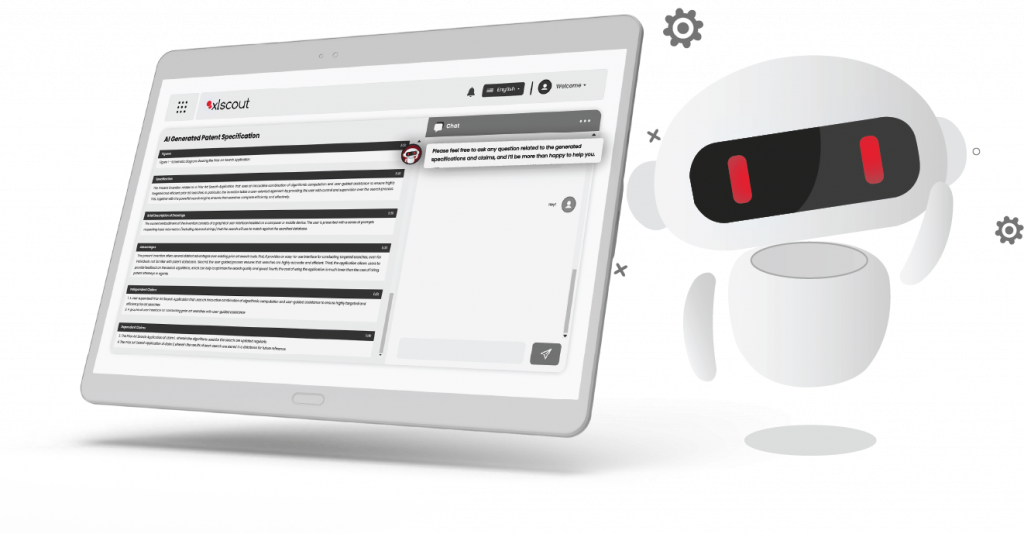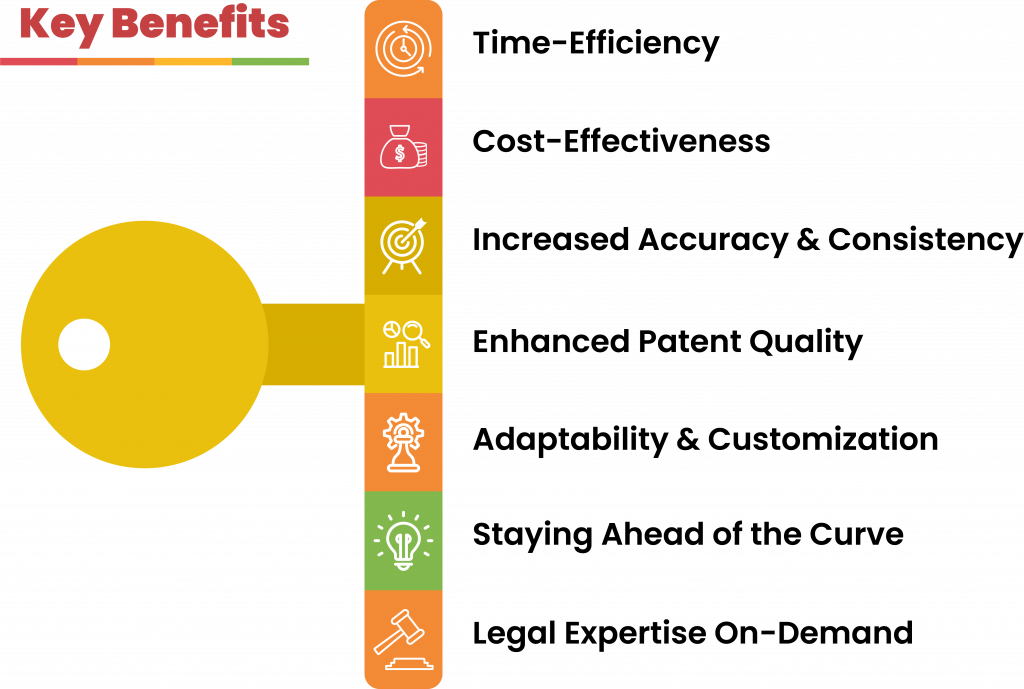
Intellectual property protection has never been more important in today’s fast-paced world of technological advancement. Patents are a cornerstone of innovation protection, providing inventors with exclusive rights to their creations. However, the patent drafting process can be complex and time-consuming, necessitating specialized knowledge and legal expertise.
Enter the era of automated patent drafting, in which artificial intelligence (AI) takes center stage in revolutionizing the creation of patent applications. This cutting-edge technology uses the power of large language models (LLMs) and generative AI to streamline the patent drafting process, benefiting inventors, businesses, and legal professionals alike.
The Rise of Automated Patent Drafting
Before delving into the advantages of automated patent drafting, let’s first define it. The introduction of automated patent drafting represents a watershed moment in the evolution of intellectual property management.
Traditionally, patent drafting was a time-consuming process that required extensive knowledge of both technical fields and legal complexities. However, with the advent of artificial intelligence (AI) and advanced natural language processing (NLP) algorithms, the patent workflows are changing.
Harnessing the Power of AI
To generate patent applications, automated patent drafting relies on the capabilities of sophisticated AI models, particularly large language models. These models are trained on massive corpora of legal texts, technical documents, and patent filings, allowing them to comprehend and reproduce the complexities of patent language and structure.
Accelerating Innovation
One of the most notable characteristics of automated patent drafting is its ability to speed up the patenting process. Traditionally, drafting a comprehensive patent application could take months, with numerous revisions and legal consultations.
With AI at the helm, this process can be sped up to allow inventors to move forward with their innovations more quickly.
Democratizing Patent Protection
By reducing the time and resources required for drafting, automated patenting levels the playing field for inventors and businesses. It makes patent protection more accessible to startups, independent inventors, and small enterprises that may not have the financial resources to engage specialized legal experts for extended periods.
How to Draft a Patent Application Using AI
- Conceptualization and Disclosure: The process begins with the inventor describing a detailed description of the innovation, including its unique features, functions, and potential applications.
- Keyword Integration: The AI system utilizes specialized algorithms to identify and incorporate relevant keywords, ensuring the patent application aligns with industry-specific terminology and legal requirements.
- Claim Generation: One of the most critical aspects of a patent application is the claims section, which defines the scope of protection. AI analyzes the disclosed information to generate precise and comprehensive claims.
- Technical Language and Legal Compliance: The AI system ensures that the language used in the patent application is technically accurate and legally compliant, reducing the likelihood of rejection or disputes.
- Formatting and Documentation: The final step is to format the document as per the patent office guidelines, ensuring a professional and polished submission.
Key Benefits of Automated Patent Drafting
1. Time-Efficiency
In the world of innovation, time is of the essence. Traditional patent drafting can be a time-consuming process that involves numerous revisions and legal reviews. The AI-powered system accelerates the process with automated patent drafting, significantly reducing the time required to draft a comprehensive application.
Additionally, the time saved by automated patent drafting can be redirected to critical research and development efforts. Instead of being bogged down by the administrative complexities of patent drafting, innovators can focus on refining their inventions and exploring new avenues.
This accelerated patenting process has far-reaching implications for industries as a whole. It encourages inventors to bring their ideas to market more quickly by promoting a culture of rapid innovation. This, in turn, accelerates technological advancements and creates a more dynamic and competitive marketplace.
Furthermore, in industries where technological advancements occur at breakneck speed, such as software development and electronics, the speed of automated patent drafting is especially advantageous. It ensures that inventors can protect their innovations before they become obsolete or are copied by competitors.
Moreover, when navigating international patent systems, time is very crucial. The requirements and timelines for patent applications vary by jurisdiction. Automated patent drafting can adapt to these diverse needs, ensuring that inventors can navigate the global patent landscape efficiently and obtain timely protection for their innovations.
2. Cost-Effectiveness
Hiring specialized patent attorneys and experts can be an expensive proposition. Automated patent drafting is a low-cost option that eliminates the need for extensive legal consultations and revisions. The patenting process is thus democratized, making it more accessible to a broader range of inventors and businesses.
Furthermore, automated patent drafting not only reduces direct legal costs but also contributes indirectly to overall cost savings. Traditional patent drafting entails numerous iterations, legal consultations, and revisions, all of which can add up to substantial costs over time. Many of these repetitive tasks are streamlined by automated systems, significantly reducing associated costs.
This cost-effectiveness is especially advantageous for small and medium-sized businesses (SMEs) and individual inventors with limited financial resources. It leveled the playing field, allowing them to compete on a more equal footing with larger corporations with large legal budgets.
Furthermore, automated patent drafting can assist businesses in allocating their resources more strategically. Companies can allocate funds to other critical areas, such as research and development, marketing, or production by reducing the financial burden of the patenting process. This allows them to invest in areas that directly contribute to their company’s growth and success.
Moreover, in industries with rapid innovation and a high volume of patent applications, such as IT, the cost savings from automated patent drafting can be especially significant. This enables businesses to devote more resources to the filing of additional patent applications, thereby expanding their intellectual property portfolios and solidifying their competitive advantage.
By democratizing the patenting process, automated drafting ensures that innovation is not limited to a small group of wealthy individuals. It enables a wide range of inventors, including individuals, startups, and SMEs, to protect their intellectual property and bring their ideas to market without being stymied by prohibitively expensive costs.
3. Increased Accuracy and Consistency
AI-powered systems are intended to eliminate human inconsistencies and errors. Using advanced algorithms, automated patent drafting ensures that the application is meticulously crafted and adheres to the highest accuracy and coherence standards.
Furthermore, the increased accuracy and consistency provided by automated patent drafting has far-reaching consequences for the overall quality and effectiveness of the patent application.
Even the most meticulous professionals may overlook details or make minor errors in traditional drafting. These could range from typographical errors to more substantive issues, such as inadequate descriptions or claims. Such mistakes can have serious ramifications, potentially undermining the patent’s enforceability or validity.
AI-powered systems, on the other hand, are designed to operate with unwavering attention to detail. They thoroughly review every aspect of the application, from technical descriptions to legal language, to ensure that all aspects meet the highest standards. This not only reduces the possibility of clerical errors but also aids in the creation of a comprehensive and robust patent application.
Furthermore, automated patent drafting systems are immune to inconsistencies caused by multiple people working on a patent application. Different drafters may interpret legal requirements or technical details differently, resulting in inconsistencies in the final document. There is a consistent and standardized approach with an AI-powered system, ensuring that all elements of the application are aligned and coherent.
The increased accuracy and consistency extend to the application’s alignment with legal requirements and precedents. AI-powered systems can analyze massive datasets of existing patents, legal documents, and rulings. This allows them to create applications that strictly adhere to legal standards, lowering the likelihood of issues arising during the examination process.
4. Enhanced Patent Quality
A well-written patent application has a better chance of being approved, providing strong protection for the innovation. The resulting patent application is of superior quality, thanks to AI’s precision and expertise, increasing the chances of successful approval.
Furthermore, the improved patent quality enabled by automated drafting extends beyond the application process and is critical to the overall value and protection of the innovation.
A well-drafted patent application forms the basis for a strong and enforceable patent. It describes the invention in detail, including technical details, distinguishing features, and potential applications. This level of detail is critical in establishing a solid foundation for the patent’s claims, which define the scope of protection.
AI-powered systems excel at producing detailed and precise descriptions. They can dissect complex technical concepts and articulate them in a way that is both technically correct and legally sound. This precision in language and terminology ensures that the patent application is clear, unambiguous, and able to withstand rigorous examination during the examination process.
Furthermore, the expertise embedded in automated patent drafting systems is derived from extensive research of patent data, legal precedents, and technical literature. This wealth of knowledge is used to ensure that the resulting application is not only of high quality but also strategically placed within the intellectual property landscape. It aids in the formulation of claims that are broad enough to provide meaningful protection while remaining specific enough to be granted by patent offices.
Additionally, the high-quality patent applications produced by automated systems are more likely to withstand future challenges or disputes. A well-drafted and meticulously crafted application serves as a formidable defense in cases where the validity or scope of a patent is called into question.
Finally, the improved patent quality obtained through automated drafting directly translates into a higher likelihood of approval and a stronger foundation for protecting the innovation. As a result, the overall value of intellectual property increases, making inventors a more powerful asset in the competitive landscape.
5. Adaptability and Customization
Patent drafting solutions that are automated can be tailored to specific industries, technologies, and legal requirements. This adaptability ensures that the generated applications are precisely aligned with each innovation’s unique needs and nuances.
Furthermore, the adaptability and customization features of automated patent drafting provide a level of flexibility and precision that is invaluable in the complex intellectual property landscape.
When it comes to patent applications, different industries have different requirements. A pharmaceutical patent’s technical language and specifications, for example, may differ significantly from those of a software-related invention. These nuances can be seamlessly integrated into the drafting process with automated systems.
Furthermore, specific technologies frequently have their own set of complexities and specialized terminology. Automated patent drafting solutions can grasp these technical details and incorporate them into the application accurately and coherently. This ensures that the patent application not only meets legal requirements but also effectively communicates the innovation’s uniqueness and value.
Legal requirements and standards can also differ between jurisdictions. For example, patentability criteria in the United States may differ from those in Europe or Asia. Automated systems can be programmed to account for these variations, resulting in applications that are tailored to each jurisdiction’s specific requirements.
6. Staying Ahead of the Curve
Being the first to secure a patent can provide a significant advantage in a competitive landscape. Automated patent drafting speeds up the process, giving inventors an advantage in protecting their innovations.
Furthermore, staying ahead of the curve through automated patent drafting provides strategic advantages in a highly competitive business environment.
In industries characterized by rapid advancements and breakthroughs, innovation often thrives. Being the first to obtain a patent can be transformative. It creates a proprietary right that can act as a barrier to entry for competitors, giving the innovator a competitive advantage in the market.
Automated patent drafting speeds up the patenting process, allowing inventors to file applications more quickly. This rapid pace can make a significant difference, particularly in industries where new technologies quickly become obsolete or where multiple parties compete to patent similar innovations.
Furthermore, the ability to obtain a patent quickly corresponds to the agile nature of many modern industries. Every second counts in industries like software development, biotechnology, and electronics, where product life cycles can be incredibly short. Automated patent drafting ensures that inventors can quickly and efficiently navigate the patenting process, allowing them to capitalize on the market potential of their innovations.
Furthermore, being at the forefront of industries driven by disruptive technologies or emerging trends can confer a significant competitive advantage. It enables innovators to establish collaborations, set industry standards, and gain a strong market foothold.
This proactive approach also shows potential partners, investors, and stakeholders that the inventor is serious about protecting and commercializing their intellectual property. It boosts the innovation’s overall credibility and attractiveness to potential collaborators or investors.
7. Legal Expertise On-Demand
Patent drafting systems that are automated, incorporate the expertise of legal professionals and patent attorneys into their algorithms. This means that inventors can reap the benefits of legal experts’ collective knowledge and experience without incurring the associated costs.
Furthermore, the incorporation of legal expertise into automated patent drafting systems revolutionizes inventors’ access to specialized knowledge and advice.
Legal professionals and patent attorneys are well-versed in patent laws, regulations, and precedents. Their knowledge is critical in ensuring that patent applications are written in a way that maximizes their chances of approval while also providing strong protection for innovation.
Automated patent drafting systems make use of this expertise by incorporating it into their algorithms. This means that inventors can tap into this reservoir of legal knowledge without having to engage in lengthy, and often expensive, consultations with legal experts. The system itself becomes a repository of legal best practices, ensuring that every generated application adheres to established legal standards.
Furthermore, the availability of this legal expertise on demand is especially beneficial for inventors who may not have immediate access to specialized legal professionals. This is especially true for individual inventors, startups, or small businesses with limited resources for legal consultations.
Additionally, automated patent drafting systems ensure that legal expertise is applied consistently. Different legal professionals may interpret or approach patent drafting differently. An AI-powered system applies legal principles consistently and systematically, reducing the possibility of inconsistencies or errors.
Furthermore, as patent laws change and legal precedents shift, automated systems can be updated to account for these shifts. This ensures that the generated applications remain compliant with the most recent legal standards giving inventors a competitive advantage in the ever-changing intellectual property landscape.
The Future of Patent Drafting
As the field of artificial intelligence evolves, so will the capabilities of automated patent drafting. We can expect even greater precision, customization, and efficiency in the patenting process as natural language processing and machine learning advance.
Future Developments in Automated Patent Drafting
Looking ahead, automated patent drafting is set to evolve further. Here are some predictions for the future:
1. Improved Natural Language Processing (NLP)
Future versions of automated patent drafting systems will almost certainly include more sophisticated NLP algorithms. As a result, the AI will be able to better understand nuanced technical concepts and industry-specific terminology, resulting in more accurate and precise patent applications.
2. AI-Generated Prior Art Searches
Conducting prior art searches to ensure the novelty of the invention is currently one of the most time-consuming aspects of patent drafting. In the future, AI systems may be capable of conducting comprehensive prior art searches autonomously, speeding up the drafting process even further.
3. Enhanced Customization for Specific Industries
We can expect automated patent drafting solutions tailored to specific industries as AI technologies become more specialized. These systems will have a thorough understanding of the specific needs and terminology of various industries, resulting in highly customized and industry-relevant patent applications.
Automated Patent Drafting with XLSCOUT’s Drafting LLM

XLSCOUT’s Drafting LLM utilizes cutting-edge technologies like Large Language Models (LLMs) and Generative AI to generate preliminary patent drafts, thus saving time, increasing speed and efficiency, and ensuring accuracy.
Time Efficiency with AI-Powered Patent Drafting
Drafting LLM reduces the time required to generate initial drafts significantly, allowing the user to devote more time to higher-level tasks.
Precision in Technical Terminology
Drafting LLM leverages LLMs to comprehend and apply specific technical terminology, ensuring the accuracy of descriptions and claims.
Conclusion
In conclusion, automated patent drafting represents a paradigm shift in the way intellectual property protection is approached. Using AI, inventors, and businesses can navigate the patenting process more quickly, accurately, and cost-effectively. Adopting this transformative technology is not only a strategic move for individual innovators, but it is also a significant step forward for the entire intellectual property rights landscape. Looking forward, the continued evolution of AI promises even more sophisticated and efficient patent drafting solutions, further empowering inventors in their quest to protect and share their innovations with the rest of the world.
Discover the future of patent drafting with XLSCOUT! Experience lightning-fast, pinpoint-accurate patent drafts in record time. Connect with us at contact@xIscout.com to learn more about our Al-powered solutions and how we can assist you in generating precise and accurate patent drafts.


